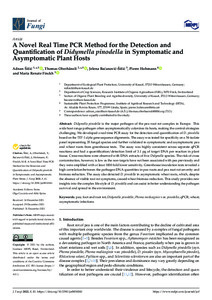A Novel Real Time PCR Method for the Detection and Quantification of Didymella pinodella in Symptomatic and Asymptomatic Plant Hosts
| dc.date.accessioned | 2022-02-22T13:05:34Z | |
| dc.date.available | 2022-02-22T13:05:34Z | |
| dc.date.issued | 2021-12-31 | |
| dc.identifier | doi:10.17170/kobra-202202225796 | |
| dc.identifier.uri | http://hdl.handle.net/123456789/13649 | |
| dc.description.sponsorship | Gefördert durch den Publikationsfonds der Universität Kassel | |
| dc.language.iso | eng | |
| dc.rights | Namensnennung 4.0 International | * |
| dc.rights.uri | http://creativecommons.org/licenses/by/4.0/ | * |
| dc.subject | pea | eng |
| dc.subject | foot and root rot | eng |
| dc.subject | Didymella pinodella | eng |
| dc.subject | Phoma medicaginis var. pinodella | eng |
| dc.subject | qPCR | eng |
| dc.subject | wheat | eng |
| dc.subject | asymptomatic infections | eng |
| dc.subject.ddc | 630 | |
| dc.title | A Novel Real Time PCR Method for the Detection and Quantification of Didymella pinodella in Symptomatic and Asymptomatic Plant Hosts | eng |
| dc.type | Aufsatz | |
| dcterms.abstract | Didymella pinodella is the major pathogen of the pea root rot complex in Europe. This wide host range pathogen often asymptomatically colonizes its hosts, making the control strategies challenging. We developed a real-time PCR assay for the detection and quantification of D. pinodella based on the TEF-1 alpha gene sequence alignments. The assay was tested for specificity on a 54-isolate panel representing 35 fungal species and further validated in symptomatic and asymptomatic pea and wheat roots from greenhouse tests. The assay was highly consistent across separate qPCR reactions and had a quantification/detection limit of 3.1 pg of target DNA per reaction in plant tissue. Cross-reactions were observed with DNA extracts of five Didymella species. The risk of cross contamination, however, is low as the non-targets have not been associated with pea previously and they were amplified with at least 1000-fold lower sensitivity. Greenhouse inoculation tests revealed a high correlation between the pathogen DNA quantities in pea roots and pea root rot severity and biomass reduction. The assay also detected D. pinodella in asymptomatic wheat roots, which, despite the absence of visible root rot symptoms, caused wheat biomass reduction. This study provides new insights into the complex life style of D. pinodella and can assist in better understanding the pathogen survival and spread in the environment. | eng |
| dcterms.accessRights | open access | |
| dcterms.creator | Šišić, Adnan | |
| dcterms.creator | Oberhänsli, Thomas | |
| dcterms.creator | Baćanović-Šišić, Jelena | |
| dcterms.creator | Hohmann, Pierre | |
| dcterms.creator | Finckh, Maria Renate | |
| dc.relation.doi | doi:10.3390/jof8010041 | |
| dc.subject.swd | Infektion | ger |
| dc.subject.swd | Erkennung | ger |
| dc.subject.swd | Echtzeitbildverarbeitung | ger |
| dc.subject.swd | Quantifizierung | ger |
| dc.subject.swd | Erbse | ger |
| dc.subject.swd | Weizen | ger |
| dc.subject.swd | Wurzelfäule | ger |
| dc.type.version | publishedVersion | |
| dcterms.source.identifier | eissn:2309-608X | |
| dcterms.source.issue | Issue 1 | |
| dcterms.source.journal | Journal of Fungi | eng |
| dcterms.source.volume | Volume 8 | |
| kup.iskup | false | |
| dcterms.source.articlenumber | 41 |
Dateien zu dieser Ressource
Das Dokument erscheint in:
-
Artikel [1106]


